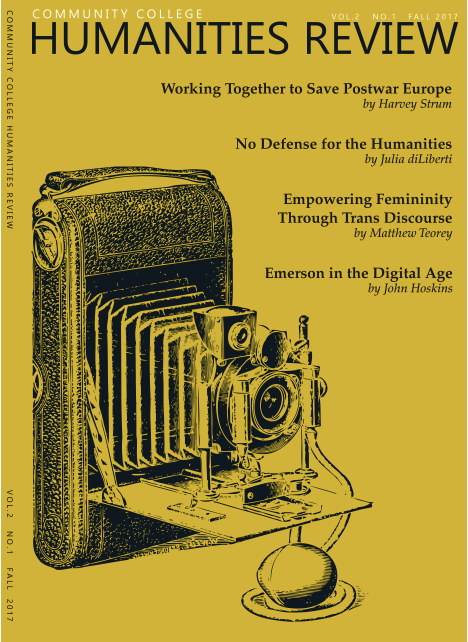Want a peek at the CCHR? See the teasers below!
The Community College Humanities Review Journal
The Community College Humanities Review (CCHR) journal, published biannually by the Community College Humanities Association (CCHA), has gone through an extensive redesign and reevaluation of editorial content. Along with the publication’s historical penchant for outstanding peer-reviewed scholarship, CCHR is now publishing essays on pedagogy, faculty profiles, book reviews, columns, fiction, poetry, and first-person reflections on life as a community college humanities professor. Further information on our Submission Guidelines below.
For “conventional” humanities disciplines such as history, philosophy, literary studies, composition, comparative religion, and ethics, CCHR provides the latest in research and pedagogy. The publication also leads the charge in expanding the definition of what studying the humanities may come to mean in the future. CCHR intends to explore, from a humanities perspective and with the intention of building bridges with other disciplines, such subjects as climate change, income inequality, environmental racism, terrorism, sustainability, media literacy, and biotechnology.
With expanded editorial content, CCHR is better able to serve CCHA’s members, as well as reach the larger higher education humanities community. CCHR is the go-to for the past, present, and future of humanities education in community colleges. Since the re-launch, CCHR has assumed its position as the signature publication of the Community College Humanities Association and be a welcome and important contribution for any individual and/or institution where the humanities are taught or explored.
Edited by Sydney Elliott, Volume 2, Number 1 of The Review is available via Amazon by clicking the link below. Additionally, more information about our Submission Guidelines can be found HERE.


.
Get the Community College Humanities Review Journal (CCHR) delivered to your library; it’s easy to do! Masyn Phoenix, Library Director at Tillamook Bay Community College, is here to tell you how just how easy it is. “Subscribing to the Community College Huamnities Review is easy. Just ask your friendly neighborhood librarian to subscribe for you through EBSCONET. ISSN# 0748-0741.” Thanks, Masyn!
Want a peek at the CCHR? See the teasers below!
Contact information
Sydney Elliott, Editor
sydneyelliott@tillamookbaycc.edu
Submission guidelines
Community College
HUMANITIES REVIEW
The Community College Humanities Review is published by the Community College Humanities Association (CCHA). The goal of the journal is to highlight the scholarly and creative work of community college humanities faculty. The editor encourages progressive approaches to writing about the humanities in community colleges, welcoming but also questioning conventional subject matter while inviting community college humanities faculty to take a fresh look at, for example, culture, the environment, the politics of food, climate change, genetic engineering, whatever new challenges a humanities mindset may help, in an integrated approach with other disciplines, to solve. The Community College Humanities Review strives to be the go to publication for community college humanities scholarship and creativity.
Submission Guidelines
Writing
Please query CCHR’s editor, Sydney Elliott, at sydneyelliott@tillamookbaycc.edu. Submissions will only be accepted through email in MS Word, 12 point, Times New Roman font, double spaced, left justified, with one-inch margins and page numbers in the upper right corner. There should be no headers or footers. CCHR rarely accepts any work over 7,000 words. Most texts should fall between the 2,000 – 7,000 word range. For additional format requirements concerning research submissions, see below.
Research
CCHR accepts well-researched articles by community college humanities faculty. Along with the above writing guidelines, scholar writers should follow MLA format and use endnotes (not footnotes) when necessary. Please restrict the number of explanatory or digressive endnotes that are excessively long. Limit the total number of endnotes to bibliographic references. Use superscript Arabic numbers in text, avoid the use of other symbols like asterisks. Embed tables, figures, charts, graphs into the narrative as close to the in-text reference as possible. Limit the number of appendixes.
Creative Nonfiction
Essays – CCHR accepts well-written personal experience and critical essays as well as long-form, literary journalism written by community college humanities faculty. Essays on novel pedagogy and teaching experiences are encouraged.
Profiles – Creative profiles in the long-form tradition should focus on community college humanities faculty or those who are in some significant way associated with community colleges.
Interviews
Interviews, in Q&A format, will be accepted as long as the interview subject has particular relevance to the teaching of humanities in community colleges. Please query Editor Sydney Elliott.
Fiction
CCHR accepts well written short stories of any genre, generally 1,000 to 7,500 words. Higher consideration is given to quality writing and the ability to tell a good story. Both character- or plot-driven stories welcome for review. CCHR publishes one short story per issue, more depending on the discretion of the editor. Send your best work. No previously published material. Yes on simultaneous submissions.
Poetry
Poets may submit up to five poems in any form. Publication design guidelines prohibit the guarantee of poet-designated line breaks. We’ll do our best to accommodate. Thoughtful, imaginative poems should resonate. Send your very best work. No previously published material. Simultaneous submissions are ok.
Photography
Subject to the editor’s discretion, The Community College Humanities Review accepts photography by community college humanities faculty. Photos may need to be conducive to the thematic content of a particular issue.
Sneak Peek
Harvey Strum:
“Working Together to Save Postwar Europe”
American political leaders in the 19th Century and early 20th Century considered foreign aid unconstitutional. For example, bills proposed in Congress to provide $500,000 for Irish and Scottish relief in 1847 during the Great Hunger and $300,000 for Irish relief in 1880 during the Little Famine failed because of the opposition of members of Congress and Democratic President James K. Polk and Republican President Rutherford B. Hayes. Instead, Americans organized voluntary committees to raise money and send food abroad. Clara Barton and the American Red Cross, not the United States government, sent a relief mission to the Ottoman Empire in 1896 to help the victims of the Armenian genocide of 1894-96. A citizens committee, Committee on Armenian Atrocities raised $116,000,000 from 1915 to 1929 to help the survivors of the Ottoman genocide of Armenians.
When World War II broke out, Americans organized committees for and against intervention in the war recreating the pattern of previous committees established by Americans in response to foreign policy issues. ese included the anti-interventionist America First, pro-interventionist Century Group, all aid short of war committee—the Committee to Defend America by Aiding the Allies. After the war, Americans concerned about the budding Cold War, the policies of the USSR, and the need to rebuild war shattered European economies, joined together to support an initiative of the President Harry Truman, the European Recovery Program or Marshall Plan. People across the political spectrum who shared an internationalist vision and a desire to stop the spread of communism in Europe joined in non-partisan citizens committee that included Republicans and Democrats. e Committee for the Marshall Plan, or Stimson Committee, provides a rare example of a non-partisan citizens committee that lobbied for passage of the Marshall Plan. Members of the committee supported a Truman foreign policy initiative, but also worked closely with Republican Chairman of the Senate Foreign Relations Committee Arthur Vandenberg to assure passage of the legislation. e committee included people as diverse in their political opinions as the conservative Republican chair of the committee, Henry Stimson, Secretary of State under President Herbert Hoover and Secretary of War in the Franklin Roosevelt and Harry Truman administrations; Mrs. Wendell Willkie, the widow of the 1940 Republican presidential candidate; right of center Democrat Dean Acheson who would become Truman’s third Secretary of State; liberal Hubert Humphrey, the Democratic-Farmer-Labor Party mayor of Minneapolis and later Senator from Minnesota and Vice-President under Lyndon Johnson; and liberal Alger Hiss, an expert on foreign economic policy who worked for the Roosevelt and Truman administrations.
A few months after the Stimson Committee disbanded, the House Un-American Activities Committee and Congressman Richard Nixon denounced him as a communist and agent of the USSR. Studying the Stimson Committee is important to our understanding of how the Marshall Plan won approval and how Americans who shared a common purpose worked together across party lines. A determined group of Americans put aside partisan and ideological differences and cooperated to lobby for passage of the most successful American foreign policy initiative, Marshall Plan, that rebuilt the economies of western Europe. Without the e orts of the members of the Stimson Committee, the Marshall Plan would probably have not won approval of the Republican majority in Congress in 1948.
Want to continue reading? Please consider purchasing a print copy or becoming a member.
Sneak Peek
Julia diLiberti:
“No Defense for the Humanities”
Everyone recalls the majestic exordium of Webster’s reply to Hayne. “Mr. President,” he began, “when the mariner has tossed for many days in thick weather, and on an unknown sea, he naturally avails himself of the first pause in the storm, the earliest glance of the sun to take his latitude and ascertain how far the elements have driven him from his true course,” (Allan Nevins “In Defense of History”).
Seated at the roaring loom of time, for six thousand years man has woven a seamless garment. But that garment is invisible and intangible save where the dyes of written history fall upon it, and forever preserve it as a possession of generations to come (Allan Nevins “Defense”).
In his Discourse on the Arts and Sciences, Jean-Jacques Rousseau offers the following on the inherent treachery of the arts:
While government and laws take care of the security and the wellbeing of men in groups, the sciences, letters, and the arts, less despotic and perhaps more powerful, spread garlands of flowers over the iron chains which weigh men down, snuffing out in them the feeling of that original liberty for which they appear to have been born, and make them love their slavery by turning them into what are called civilized people.
Whether we agree with Rousseau’s critique of the arts and letters he, nonetheless, attributes to them a stunning power. Modern humanists are more likely to suggest that the arts and letters allow us to cast off our chains by first making us aware of their very presence. Whichever way the argument is made, the inherent power of the arts is acknowledged, and therein lies their danger: if they expose tyranny, they should be suppressed. If they reinforce it, they become a dangerous tool of the tyrant. In short, the Humanities are influential instruments of insight and criticism which is, perhaps more than any other reason bandied about, why they are often less funded, given less support, and taken less seriously than fields where improving the conditions of humans is prized over the human condition. The power of the Humanities is never the argument offered for underfunding or discounting them; on the contrary, humanists, instead, are made to believe that their disciplines lack power and relevance to politics, production, and the populace in general. We have begun to believe this, so much so that scholars seem weekly to take up the defense of the Humanities in attempts to validate their worth. The irony: In the assumption that such arguments need be made, the Humanities lack of worth has been conceded.
Perhaps, because the benefits derived from studying the Humanities are often not physically tangible, or (gasp!) measurable through the reduction of their worth to a point of data on “assessment” projects, we begin to mount our defenses hoping to change the minds of those who see no immediately quantifiable value in the humanities and so can rarely, if ever, be convinced of their worth. Thus, do our vigorous defenses typically serve only to remind us why we and our like-minded colleagues personally find value in our disciplines. Often vague and unsatisfying, or perhaps shifting towards finding data points which we feel could least misrepresent our disciplines in the reductionist way we are all asked to distill teaching, learning, and outcomes as numbers, we nonetheless try to justify our existence to those adamantly opposed to seeing the humanities as relevant to our world and its survival.
Want to continue reading? Please consider purchasing a print copy or becoming a member.
Sneak Peek
Matthew Teorey:
“Empowering Femininity Through Trans Discourse”
Empowering Femininity through Trans Discourse in Ana Castillo’s Peel My Love Like an Onion and Virginia Woolf ’s Orlando.
Transgenderism has recently gained more public attention. In 2015, the best actor Golden Globe went to Jeffry Tambor for portraying transgendered Maura on hit television series Transparent, and only a few months later major media outlets vied for the opportunity to interview former Olympian Bruce Jenner, now Caitlyn Jenner, as she explained her gender transition. A 2017 ACLU report states that a large number of state and local laws passed in the last few years “clearly prohibit discrimination against transgender people” (“Know Your Rights”). This legislation is one response to the anti-transgender bills passed in several states, most notably in North Carolina and Texas, as well as the continued nation-wide discrimination against transgendered people. In addition to the work of public activists, a number of fiction authors have championed the notion that one’s gender identity could come from within rather than being imposed by society’s stereotypes about one’s sex. Quite a few texts have rejected the patriarchal belief that femininity is inferior to masculinity, yet few texts feature a transgendered character as their feminist spokesperson. This essay closely examines how two pioneering texts, Ana Castillo’s 1999 novel Peel My Love Like an Onion and Virginia Woolf’s 1928 novel Orlando, each use a transgendered character to re-conceptualize femaleness and empower femininity.
Early in Castillo’s novel, the protagonist Carmen offends her friend Chichi, a male whose sexual preference is men, by asking, “Are you [gay]?” (47) Chichi is not a self-hating homosexual or in denial, quite the opposite. She is a pre-operative transsexual, who proudly identifies as female and heterosexual. By repudiating Chichi’s non-traditional expression of womanhood and heterosexuality, Carmen engages in what transgender activist Emi Koyama termed “cis-sexism” (“Cissexual/ Cisgender”). Chichi recognizes, however, that the insensitive comment reveals less about Carmen’s transphobia and more about her own gender unhappiness and sexual insecurities. It indicates how powerless and worthless a woman can feel within the binary gender system, confined by what William Pollack has termed the “gender straitjacket” (396)—society’s demand that a woman perform only stereotypical female behavior, a role for which society dismisses her as weak and inferior. Chichi, on the other hand, finds power and authority in her femininity. Her trans womanhood challenges gender essentialism and social hierarchy, thereby confounding the belief, promulgated by some second-wave radical feminists like Janice Raymond, that the male-to-female transsexual can never be a “true” woman and instead must “become a caricature of much that feminists have rejected about man-made femininity” (xviii-xix). Chichi, a transfeminist, becomes indignant at having her womanhood questioned; she is not upset at Carmen but at the degrading patriarchal assumptions and limitations that Carmen has adopted.
Want to continue reading? Please consider purchasing a print copy or becoming a member.
Sneak Peek
John Hoskins:
“Emerson in the Digital Age: Reclaiming Potential Human Nature”
In our digital age, the question of what human nature is and whether it is in the midst of a technologically produced transcendence, has profound implications for the study of the humanities as well as for what we mean by “the humanities.” In a fundamental way, study of and expression through the humanities, art, literature, philosophy, history, performance, is the study and expression of what it means to be human. It is the study and contemplation of who we are and why we are here. It is an open- ended inquiry. Traditionally, it is an inward search for truth, justice, wisdom, and love; ultimately, it is the search for self-knowledge.
From the point of view of the idea that the purview of empirical science equals the limit of reality, or scientism, human nature is seen, ultimately, as empirically knowable, even quantifiable. Although the growing interest in Digital Humanities does not necessarily imply an acceptance of a scientistic vision, or an inevitable reconceiving of human nature as essentially quantitative, there is nevertheless a clear, ideological kinship between privileging the use of digital tools in the search for self- knowledge and the assumption that human nature is empirically knowable. To the degree that Digital Humanities reflects the ideology of empiricism which assumes the mind is knowable as a computer, or is like a computer merely, and that with further technological advances we will be on the way to “improving” human intelligence as well as, through biotechnology, the human organism, thereby improving or “transcending” what was traditionally thought to be human nature, perhaps ultimately melding with our machines or even being replaced by them, it abandons the idea that the search for self-knowledge is essentially inward and essentially mysterious. I do not think that the Singularity or our replacement as a species is on the near horizon yet, but ideologies that give rise to such prophecies, for instance, the New Atheism or Transhumanism, increasingly influence our conception of human nature in the culture at large as well as in academe. If our vision of who we are and hence our sense of what we are seeking to become should be reduced to technological adaptation of the organism, our search for self will be limited to an outward search. Correspondingly, then, our idea of transcendence would shift from beyond time and space to extension of time and space. Obviously, this would lead to a radical shift in what we mean by the humanities and what we mean by “being human.”
Want to continue reading? Please consider purchasing a print copy or becoming a member.
